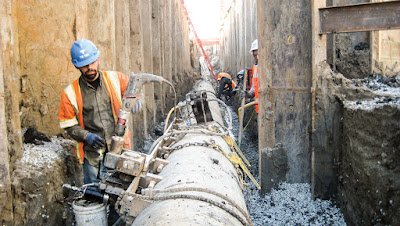An innovative Tri Tool Services on-site machining solution proved successful in carefully removing critical communication cables buried deep in the ground, a critical phase of the BART Extension Project.
The Challenge
Creating the path for the new BART extension required some buried communication cables, including fiber optic cables, be relocated into new bridge decks above the trackway.
Being in the heart of the Silicon Valley with thousands of high technology company's internet connections on the line, it was crucial that the AT&T copper wires and fiber optic communication cables remained undamaged, due to heat, cutting or debris, while they were being removed from their 205 foot long carbon steel casing.
The cables needed to be carefully machined out without requiring a hot work permit, which would delay the project even further. So everything had to be done utilizing cold cutting processes.
Background
Bay Area Rapid Transit (BART) Silicon Valley project consists of extending the BART regional heavy rail system to Milpitas, San Jose and Santa Clara. The 16-mile extension project will be completed in a phased approach with the first phase being the Berryessa Extension.
Santa Clara Valley Transportation Authority (VTA) contracted Skanska, Shimmick, Herzog to construct the Silicon Valley Berryessa Extension (SVBX). The SVBX is an approximate 10-mile extension of the existing BART that begins in the Warm Springs district of the City of Fremont, travels through Milpitas and ends in the Berryessa area of the City of San Jose.
The Solution
Skanska, Shimmick, Herzog - A Joint Venture (SSHJV) contracted by the Santa Clara Valley Transportation Authority (VTA) anticipated a 12 month turnaround from starting the communication lines relocation until completion. The original plan, by AT&T, was to lay new conduits and cables in order for the old cables to be removed. SSHJV proposed that the existing cables simply be moved, however the methods for removing live communication cables from inside of a steel pipe had not been done before. SSHJV turned to Tri Tool for an innovative solution, a company recommended to them.
Utilizing a carriage mill and modifying it to attach to the casing via a heavy duty chain versus the typical weld attachment had to be tested multiple times at Tri Tool's Rancho Cordova manufacturing facility. Once it was determined that it would remain rigid enough to perform the delicate cuts, Tri Tool deployed equipment and qualified service technicians to the site.
Securing the carriage mill to the 32 inch x .750 inch carbon steel pipe (casing), 15 feet below street level was the first step. Next two linear cuts, each approximately 205 feet in length were made along the stretch of the casing, making sure that the cut wasn't too deep and damage the vital cables nestled inside. Finally, multiple 43 inch cuts were made utilizing Tri Tool's 630RBL Clamshell Lathe mounted to the carriage mill and cutting perpendicular to the linear cuts and approximately 12 foot intervals. This created an open area that the precious cables could then be lifted out and brought above ground.
In total the project only took Tri Tool 14 days, quite a bit faster than SSHJV had anticipated. Helping to bring the job within the project ten months under schedule.
Tri Tool Performance
"I was seeking a project solution for saving VTA, AT&T and SSHJV time and money for an extensive communication cable relocation job within the SVBX BART extension project. AT&T and VTA had designed a cable relocation that required the installation of new cables, and would take one year to complete, in order for the old cables to be abandoned and removed. I believed that a better solution was "out there" but no one had the experience of relocating live communication cables which had been installed inside of a steel casing. I reached out to industry specialists and finally got a lead on Tri Tool. After speaking with the professionals at Tri Tool and explaining the challenge that I was facing, Tri Tool proposed a potential solution to the project challenge. I used Tri Tools expertise to first sell the idea to AT&T, who had never heard of anything like this, and then to VTA. After extensive coordination with Tri Too, ATT&T and VTA we were finally given the permission to try something that had not been seen or done before within the local industry. After several months of coordinating and planning we finally got Tri Tool onto the project. I simple could not be more pleased with Tri Tool's expertise, professionalism and performance in assisting myself, and the project, in overcoming what had been one of the project's largest utility challenges in preparation for the new BART extension. Tri Tool has provided stellar service an I would recommend Tri Tool to anyone who may be facing similar challenges."
Rober Fureby
Herzog Contracting
Herzog Contracting
Skanka - Shimmick - Herzog, A Joint Venture
Utility Coordinator


